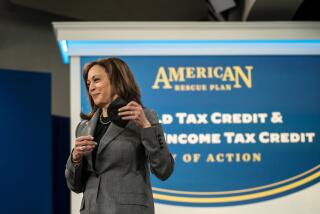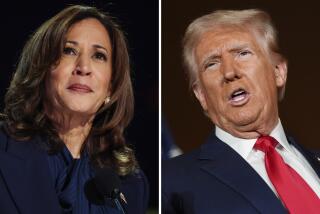Democrats Start Drafting Tax-Cut Plan : House: Alternative to Bush’s package gives a bigger break to the middle class and raises levies on the wealthy. White House opposition is expected.
WASHINGTON — Democrats on the House Ways and Means Committee began work Thursday on an alternative tax-cut package containing a larger middle-class tax reduction than President Bush is seeking, combined with a tax increase for the very rich--a move the White House is sure to oppose.
The $90.9-billion package, outlined in a closed-door caucus by panel Chairman Dan Rostenkowski (D-Ill.), would provide a $200-a-year tax credit for each taxpayer and would allow first-time home buyers to use savings from individual retirement accounts to finance purchases.
It also would reduce the taxes Americans pay on capital gains--profits from the sale of stocks or other assets--by exempting 40% of such gains from taxation, to a maximum of $80,000 of gains over a person’s lifetime.
To help pay for these reductions, the plan would raise taxes on the wealthy by boosting the tax rate on income exceeding $150,000 a year to 35%--from 31% now--and by imposing a 10% surtax, or additional tax, on those earning $1 million or more a year.
In a bow to growing popular resentment of the high salaries paid to the top officials of some companies, the plan would prohibit corporations from deducting more than the first $1 million of any executive’s salary.
No vote was taken Thursday on the package, which the Democrats claim would not increase the budget deficit--at least over the next five years. And the full package may be changed slightly when the group does approve it.
But Rostenkowski said he was “encouraged by the response” during the caucus and that he expects to produce a bill that all Democrats can support on the House floor as an alternative to Bush’s plan.
“We do focus groups and take polls . . . and you can bet that we’ll be in the 92nd percentile when we get our bill out,” Rostenkowski said.
The White House, which is expected to oppose the package produced by the committee, again decried the Democrats’ decision to draft their own tax-cut plan. Marlin Fitzwater, the President’s press secretary, likened the panel’s Democrats to “weasels going into a hole.”
“We’re going to be very tough with the Democrats who are trying to pull these games, and we intend to expose them at every opportunity,” Fitzwater said, citing in particular the Democratic plan’s tax increases.
Bush contends that he can finance his own tax-cut package with budgetary accounting changes that would not require raising taxes. But some economists have criticized his accounting proposals as “gimmicks” that should not be used to finance new tax cuts.
The Democrats on the Ways and Means Committee are scheduled to meet again this morning in hopes of completing work on the package today or Saturday. It will then be sent to the House floor as a substitute for the President’s proposal.
Largely to embarrass Bush, the Democrat-dominated committee Wednesday rejected a streamlined version of Bush’s plan that committee Republicans had sought to push through. Instead, it sent the full White House package to the House floor “without recommendation.”
Since the Democrats also have a majority in the House, Bush’s full plan is almost certain to be defeated, paving the way for the Democratic alternative.
And because the Democrats sent Bush’s bill to the House floor without offsetting spending cuts, it can be ruled out of order for violating the 1990 budget agreement. By contrast, Democrats say their plan will remain within budget guidelines by raising taxes on the rich and continuing some restrictions on tax breaks for the wealthy that were enacted in 1991. However, the plan would widen the deficit in the short run, until the tax increases kick in.
With the support of the Ways and Means panel’s Democrats, the proposal is considered likely to be endorsed by the full House Democratic caucus. House Democratic leaders are expected to go all out to gain Democratic congressional support for the package.
One example of how much Democratic thinking has changed over the past few years was the decision by Rostenkowski to include in the plan at least a limited reduction in capital gains tax rates. During the tax debate in 1990 and 1991, most Democrats opposed that idea.
Rostenkowski conceded Thursday that the proposal being considered by the caucus contains many of the same elements that Bush’s plan does. “You don’t have to be a rocket scientist to know we’re going to do some of the growth provisions the President wants,” he said.
At the same time, however, it differs markedly in many respects. The $200-a-person tax credit for taxpayers would be more generous for middle-income Americans than Bush’s proposal for a $500-per-child rise in the personal exemption, which nets $150 in tax benefits.
The Democrats discarded a White House proposal for a new “flexible” individual retirement account, which would provide most of the tax benefits up front, rather than in later years. But they doubled, to $10,000, the amount of IRA savings that Bush’s plan would allow first-time home buyers to use in financing their purchase.
The tax breaks for businesses being considered by the Democrats also differ sharply from those that Bush has proposed. The President asked for faster write-offs for business investment in new plants and equipment. The caucus plan would instead cut corporate tax rates.
And despite the turnaround in their thinking, the Democrats’ plan for cutting capital gains taxes is decidedly less generous than the one Bush proposed--particularly for upper-income investors.
Times staff writer James Gerstenzang contributed to this story.
More to Read
Get the L.A. Times Politics newsletter
Deeply reported insights into legislation, politics and policy from Sacramento, Washington and beyond. In your inbox three times per week.
You may occasionally receive promotional content from the Los Angeles Times.










